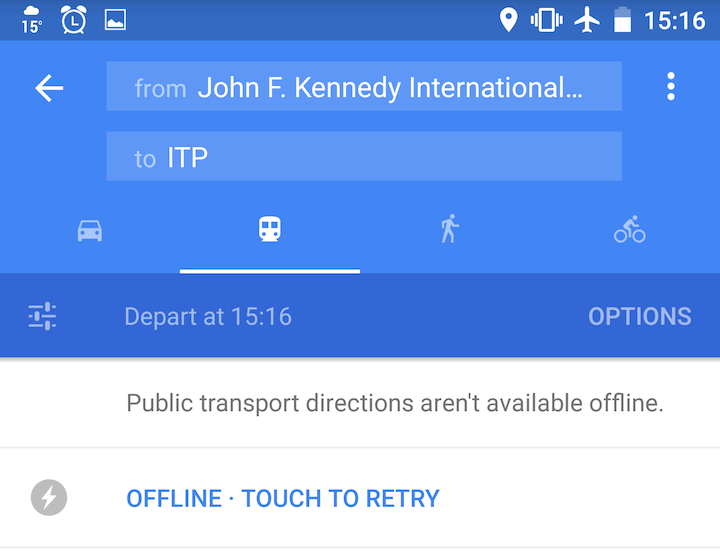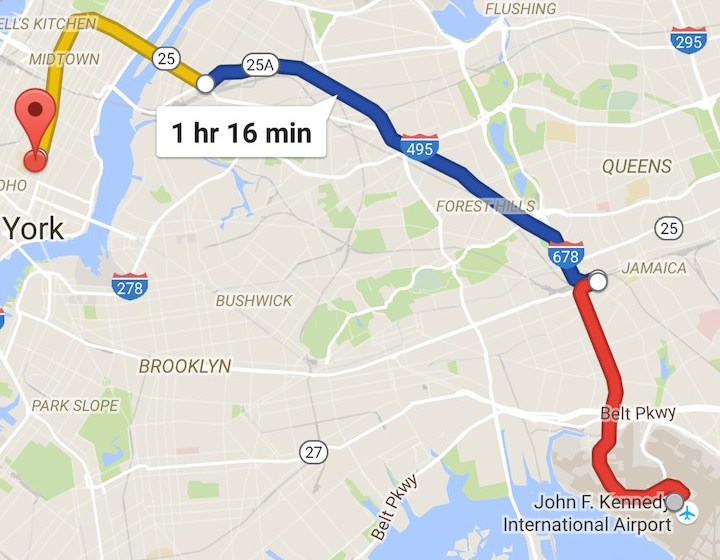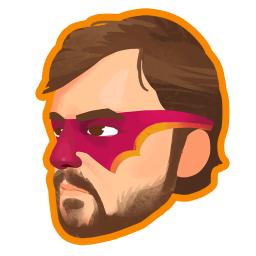Making the trains run on time
I visited New York this week, so I get to use its subway, which to me is like the parallel universe London Underground. As I got on the train on Sunday morning, just before cellphone signal vanished, I read Fred's post on the slow process of adding WiFi to the NY Subway. This reminded me of an excellent essay on how the NY subway system is a giant mechanical computer.
In preparation for this offline experience, I had cached Google Maps of NYC on my phone, but when I tried to compare routes underground, subway routing and even subway lines on the map were unavailable. It would however give me driving directions and times.


This reminded me of another problem with Google Maps Transit directions - it doesn't know when you are on the bus or train already, so it will always tell you to catch the one behind you by walking to a stop if you search to check your connection. This is an odd omission, because it is very good at locating you when driving, cycling or walking (a fun thing to do is to get driving directions, then get on Caltrain and watch Google Maps thrash desperately trying to work out which backstreet by the railway line you are driving on and redirect you back to the freeway). I do wonder if this omission is because Google runs its own buses in the Bay Area, which don't require passengers to make connections, and they have their own app for the timetable.
Now given that Google Maps already uses location data from its users to model and report traffic density, it should be able to work out when you're on a particular bus or train - especially as it can correlate across all the phone-carrying passengers, and see that they are undergoing almost identical accelerations. Which brings me back to the NY subway problem. If Google does this, it will find that it can't track trains underground, because there is no wifi or cellphone data there.
So here's my proposal for Google: sponsor wifi on subway and bus systems, and use it to track the vehicles for the passengers and the transit providers. Just having the drivers carry a cellphone would be one way to do this—Aaron Parecki and the XOXO organisers did that for their conference after all—but correlating across multiple users would be a very robust way of doing this, and give useful ridership data too. The other thing is that enabling all those subway and bus commuters to be connected ot the internet would be very much in line with the general Google policy, embodied in Google Fibre and Google Loon, that the more people use the internet, the more likely they are to use Google services, including Ads and the others that get Google paid. It may seem like a big capital expenditure, but I suspect that compared to the cost of driving every street on earth regularly for Google Maps and Street View, it will be an affordable moonshot.
 Martin Pugh liked this 9 years ago
Martin Pugh liked this 9 years ago Boon Siang Tan liked this 9 years ago
Boon Siang Tan liked this 9 years ago Aleks S. liked this 9 years ago
Aleks S. liked this 9 years ago rahul roy liked this 9 years ago
rahul roy liked this 9 years ago CathiBea Stevenson liked this 9 years ago
CathiBea Stevenson liked this 9 years ago Saurabh Kumar liked this 9 years ago
Saurabh Kumar liked this 9 years ago Clint Mendonca liked this 9 years ago
Clint Mendonca liked this 9 years ago john jj msinde liked this 9 years ago
john jj msinde liked this 9 years ago Tony Schutz liked this 9 years ago
Tony Schutz liked this 9 years ago Benedict Evans liked this 9 years ago
Benedict Evans liked this 9 years ago Md. Gulshan Islam liked this 9 years ago
Md. Gulshan Islam liked this 9 years ago Karl Puder liked this 9 years ago
Karl Puder liked this 9 years ago Justin B 🎺 liked this 9 years ago
Justin B 🎺 liked this 9 years ago Andy Finney reposted this 9 years ago
Andy Finney reposted this 9 years ago Alatitude77-infosec liked this 9 years ago
Alatitude77-infosec liked this 9 years ago lovely mariam liked this 9 years ago
lovely mariam liked this 9 years ago Rahul Lath liked this 8 years ago
Rahul Lath liked this 8 years ago Brian O'Shaughnessy liked this 8 years ago
Brian O'Shaughnessy liked this 8 years ago Thorunn Helgason liked this 8 years ago
Thorunn Helgason liked this 8 years ago Ben Wood liked this 8 years ago
Ben Wood liked this 8 years ago Rashona reposted this 8 years ago
Rashona reposted this 8 years ago CaffieneKitty liked this 8 years ago
CaffieneKitty liked this 8 years ago ManoMarks liked this 8 years ago
ManoMarks liked this 8 years ago Yuriy Dybskiy liked this 8 years ago
Yuriy Dybskiy liked this 8 years ago Tom Schenkenberg liked this 7 years ago
Tom Schenkenberg liked this 7 years ago Amanda Goldmann liked this 7 years ago
Amanda Goldmann liked this 7 years ago priya joseph liked this 4 years ago
priya joseph liked this 4 years ago Jolie O'Dell liked this 4 years ago
Jolie O'Dell liked this 4 years ago Harvey Smith
Harvey Smith Kevin Marks
Kevin Marks Tanya D. ~ Horns Up
Tanya D. ~ Horns Up Martin Pugh
Martin Pugh Kevin Marks
Kevin Marks mcc
mcc Liz Fong-Jones
Liz Fong-Jones Bertil Hatt
Bertil Hatt ⒹⒺⓃ•Ⓗ ㋡
ⒹⒺⓃ•Ⓗ ㋡